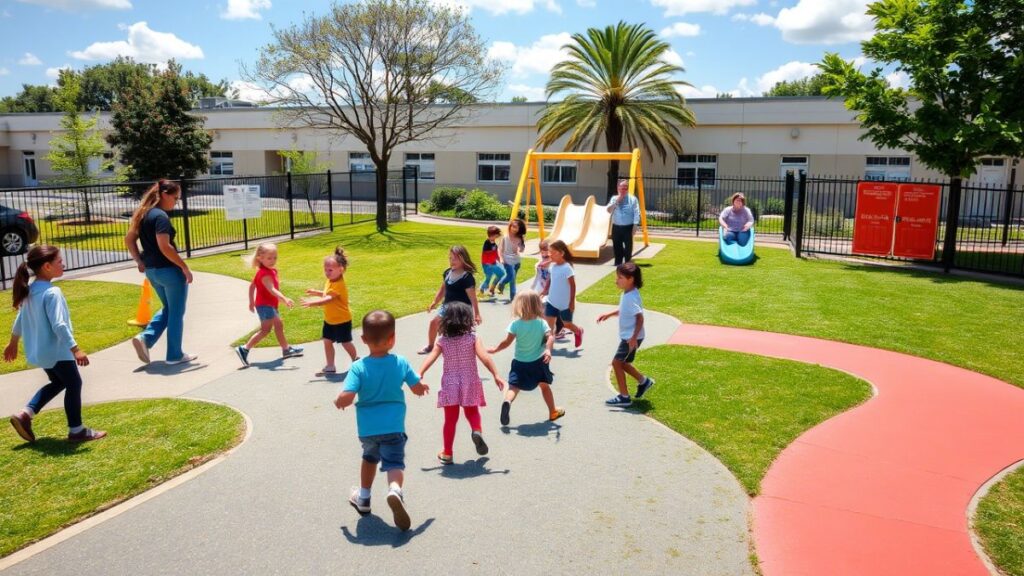Ensuring the safety of students doesn’t begin and end at the classroom door—it extends across the entire school property. From drop-off zones to playgrounds, secure school grounds play a vital role in fostering a learning environment where students feel protected and cared for. A safe school setting not only minimizes the risk of accidents or intrusions but also boosts student confidence and concentration. Here’s how schools can create secure and welcoming grounds for every student.
1. Secure Entry Points and Perimeters
The first line of defense is controlling who enters and exits the school premises. Schools should have clearly marked, limited entry points that are monitored during operational hours. Gates and fences should surround the entire campus, with secure locks and surveillance systems in place.
Visitor management is equally critical. All visitors should be required to check in through a single point—usually the front office—and wear visible ID badges. Modern technology like buzz-in systems, video doorbells, and ID scanners can enhance control and reduce risks.
2. Effective Lighting and Visibility
A well-lit campus deters unwanted behavior and increases visibility for both staff and security cameras. All key areas—such as parking lots, walkways, playgrounds, and entrances—should be adequately illuminated. Motion sensor lights can provide energy-efficient solutions, while also drawing attention to unexpected movement after hours.
Clear sightlines are just as important as lighting. Landscaping should be maintained to avoid creating blind spots or hiding places. Trees, shrubs, and hedges should be trimmed regularly to ensure unobstructed views of high-traffic areas.
3. Safe Recreational Spaces
Playgrounds and recreational areas play a vital role in students’ physical and social development, but safety must be a top priority in their design and upkeep. All play equipment should be age-appropriate, securely anchored, and routinely inspected for signs of damage or wear. To reduce the risk of injury from falls, schools should use impact-absorbing surfaces like rubber, mulch, or synthetic turf beneath and around play structures.
Consistent supervision during recess is also crucial, along with clear rules to encourage safe play. Installing sturdy fencing around the playground helps prevent unauthorized entry and ensures that children remain within designated areas. In regions like Salt Lake City, where weather can affect the integrity of paved surfaces, addressing cracks and uneven areas through professional concrete repair is essential for maintaining safe walkways and play zones. Regular maintenance not only enhances safety but also extends the life of school grounds infrastructure.
4. Traffic and Drop-Off Zone Management
Congestion during school drop-off and pick-up times can lead to accidents and confusion. Schools should design a traffic flow plan that separates buses, cars, and pedestrian traffic. Clearly marked zones, crosswalks, and signage help direct movement and improve safety.
Staff or volunteer crossing guards can provide extra protection at busy intersections or school entrances. Encouraging a staggered drop-off/pick-up schedule may also ease congestion and create a calmer environment.
5. Emergency Preparedness Plans
Even with the best preventive measures, emergencies can still occur. Schools must have comprehensive emergency plans that include lockdown procedures, evacuation routes, and reunification processes. Drills should be practiced regularly so students and staff know exactly what to do in various scenarios.
In addition, having emergency supplies like first aid kits, fire extinguishers, and communication tools readily available throughout the campus is essential. Clear signage and maps should indicate exits, shelters, and safety stations.
6. Security Technologies
Modern technology offers several tools to boost school ground safety. Security cameras positioned around entrances, hallways, and outdoor areas provide real-time monitoring and valuable footage in case of incidents.
Access control systems, such as keycards or biometric scanners, can help ensure only authorized personnel enter specific areas. Alarm systems, panic buttons, and two-way communication devices also add layers of protection.
While technology is valuable, it’s most effective when combined with human presence. Trained security personnel or school resource officers (SROs) can monitor, respond, and build trust with students.
7. Promoting a Culture of Safety
Perhaps the most powerful tool for safe school grounds is fostering a community-wide commitment to security. Students, staff, and parents should be encouraged to speak up if they notice something suspicious or unsafe. Safety education programs can teach students how to recognize risks, practice good behavior, and look out for one another.
Schools might also establish safety committees that include teachers, administrators, custodians, and parents. These groups can assess conditions, recommend improvements, and coordinate volunteer efforts to support security goals.
Final Thoughts
Creating secure school grounds is a multi-faceted task that requires attention to design, supervision, technology, and culture. When every student feels safe stepping onto campus, it sets the stage for better learning, growth, and community connection. By prioritizing safety from the parking lot to the playground, schools demonstrate their unwavering commitment to protecting the future—one student at a time.







